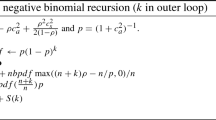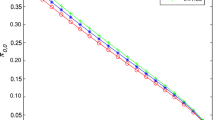Abstract
A simple random time change is used to analyze M/GI/1 queues with workload restrictions. The types of restrictions considered include workload bounds and rejection of jobs whose waiting times exceed a (possibly random) threshold. Load dependent service rates and vacations are also allowed and in each case the steady state distribution of the workload process for the system with workload restrictions is obtained in terms of that of the corresponding M/ GI/1 queue without restrictions. The novel sample path arguments used simplify and generalize previous results.
Similar content being viewed by others
References
S. Asmussen,Applied Probability and Queues (Wiley, 1987).
D.V. Barrer, Queueing with impatient customers and indifferent clerks, Oper. Res. 5 (1957) 650–656.
P. Brémaud,Point Processes and Queues (Springer-Verlag, 1981).
C.G. Cassandras and S.G. Strickland, On-line sensitivity analysis of Markov chains, IEEE Trans. Autom. Control. 34 (1989) 76–86.
J.W. Cohen, Single server queue with uniformly bounded virtual waiting time, J. Appl. Prob. 5 (1968) 93–122.
P. Franken, D. Köning, U. Arndt and V. Schmidt,Queues and Point Processes (Wiley, New York, 1982).
J. Gani and N.U. Prabhu, Continuous time treatment of a storage problem, Nature 182 (1958) 39–0.
A. Ghosal, Queues with finite waiting time, Oper. Res. 11 (1963) 919–921.
P. Glasserman and W.B. Gong, Time-changing and truncating K-capacity queues from oneK to another, J. Appl. Prob. 28 (1991) 647–655.
B.V. Gnedenko and I.N. Kovalenko,Introduction to Queueing Theory, 2nd ed. (Birkhauser, Boston, 1989).
Y.C. Ho and S. Li, Extensions of infinitesimal perturbation analysis, IEEE Trans. Autom. Control AC-33 (1988) 427–438.
H.P. McKean Jr.,Stochastic Integrals (Academic Press, 1969).
M. Miyazawa, The intensity conservation law for queues with randomly changed service rate, J. Appl. Prob. 22 (1985) 408 18.
L. Takács, The distribution of the content of finite dams, J. Appl. Prob. 4 (1967) 151–161.
L. Takács, A single server queue with limited virtual waiting time, J. Appl. Prob. 11 (1974) 612–617.
Author information
Authors and Affiliations
Rights and permissions
About this article
Cite this article
Hu, JQ., Zazanis, M.A. A sample path analysis of M/GI/1 queues with workload restrictions. Queueing Syst 14, 203–213 (1993). https://doi.org/10.1007/BF01153534
Received:
Revised:
Issue Date:
DOI: https://doi.org/10.1007/BF01153534




